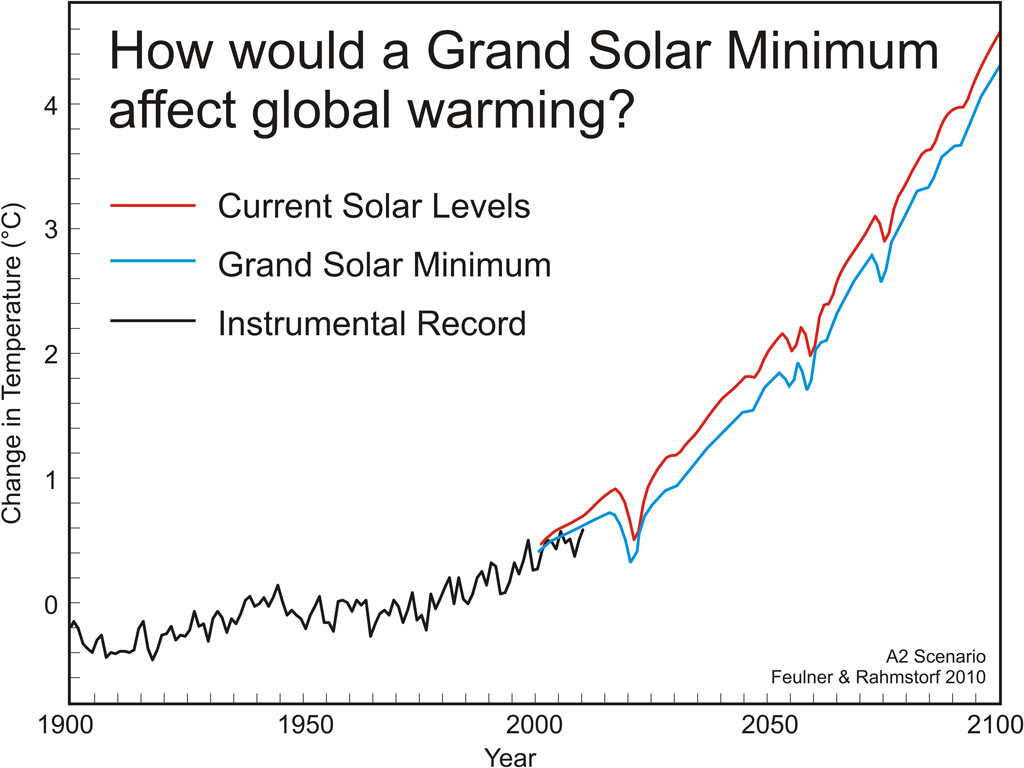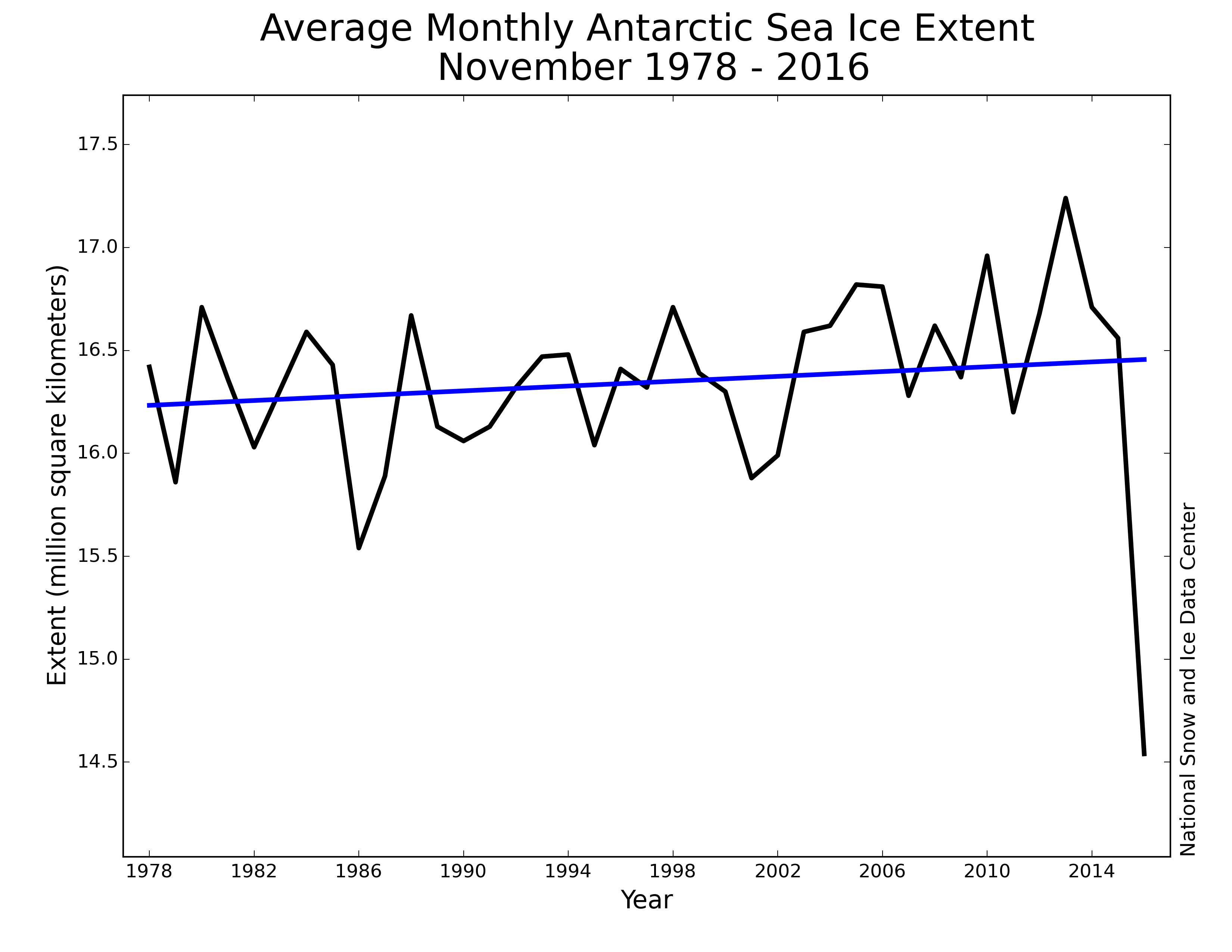A grand solar minimum would barely make a dent in human-caused global warming
Posted on 14 August 2013 by dana1981
The
Maunder Minimum was a period of very low solar activity between 1645 and 1715, and the
Dalton Minimum was a period of low (but not as low as the Maunder Minimum) solar activity between 1790 and 1830. Solar research suggests that we may have a similar period of low solar activity sometime this century.
 400 years of sunspot observations data, via Wikipedia
400 years of sunspot observations data, via Wikipedia
Recent articles in the Danish newspaper Jyllands-Posten (
translation available here) and in the
Irish Times both ran headlines claiming that another grand solar minimum could potentially trigger an "ice age" or "mini ice age" this century. These articles actually refer to the
Little Ice Age (LIA) – a period about 500 to 150 years ago when global surface temperatures were
about 1°C colder than they are today.
Thus a grand solar minimum would have to cause about 1°C cooling, plus it would have to offset the continued
human-caused global warming between 1 and 5°C by 2100, depending on how our greenhouse gas emissions change over the next century. Though in the Jyllands-Posten article, Henrik Svensmark (the main proponent of the
galactic cosmic ray-climate hypothesis) was a bit more measured, suggesting,
"I can imagine that it will become 0.2°C colder. I would be surprised if it became 1–2°C"
So these two articles are suggesting that a grand solar minimum could have a cooling effect of about 1 to 6°C, depending on how human greenhouse gas emissions change over the next century. Is it plausible that a grand solar minimum could make that happen?
The short answer is, 'No.'
Fortunately, Solar Output is Stable
We're fortunate that the amount of solar radiation reaching the Earth's surface is very stable. Climate contrarians will often ask if we'd prefer if the planet were warming or cooling, suggesting that global warming is a good thing because at least the planet isn't getting colder. This is a false dichotomy - an ideal climate is a stable one. The relatively stable climate over the past 10,000 years has allowed establishment of human civilization, by making it possible to create large stationary agricultural farms because we could rely on stable weather patterns.
What difference would a grand solar minimum make in the amount of solar energy reaching us? Relative to current levels, the Dalton Minimum represents a 0.08% decrease, and the Maunder Minimum represents a 0.25% decline in solar radiation at the Earth's surface. That's how stable solar activity is. That's also why we're playing with fire by increasing the greenhouse effect so much and so quickly. We're threatening the stability of the climate that has been so favorable to our development.
Peer-Reviewed Research Says Global Warming will Continue
There have been several studies in recent years investigating what impact another grand solar minimum would have on global surface temperatures, since solar research suggests it's possible we could be due for another extended minimum. Generally these studies will run climate model simulations under a given greenhouse gas emissions scenario with stable solar activity, then run the same scenario with the sun going into a grand minimum, and look at the difference in resulting global surface temperature changes.
Feulner & Rahmstorf (2010) (
PDF available here) estimated that another solar minimum equivalent to the Dalton and Maunder minima would cause 0.09°C and 0.26°C cooling, respectively.
 The global mean temperature difference is shown for the time period 1900 to 2100 for the IPCC A2 emissions scenario (relative to zero for the average temperature during the years 1961 to 1990). The red line shows predicted temperature change for the current level of solar activity, the blue line shows predicted temperature change for solar activity at the much lower level of the Maunder Minimum, and the black line shows observed temperatures from the NASA GISS dataset through 2010. Adapted from Feulner & Rahmstorf (2010).
Jones et al. (2012)
The global mean temperature difference is shown for the time period 1900 to 2100 for the IPCC A2 emissions scenario (relative to zero for the average temperature during the years 1961 to 1990). The red line shows predicted temperature change for the current level of solar activity, the blue line shows predicted temperature change for solar activity at the much lower level of the Maunder Minimum, and the black line shows observed temperatures from the NASA GISS dataset through 2010. Adapted from Feulner & Rahmstorf (2010).
Jones et al. (2012) (
PDF available here) arrived at a nearly identical result, with cooling from a Dalton and Maunder minimum equivalent at 0.09°C and 0.26°C, respectively. Similarly, a new paper by
Anet et al. (2013) found that a grand solar minimum will cause no more than 0.3°C cooling over the 21st century.
Consistent with these previous studies,
Meehl et al. (2013) (
PDF available here) estimate a Maunder Minimum would cause about 0.26°C cooling, but as soon as solar activity began to rise again, that cooling would be offset by solar warming. This is a key point, because a grand solar minimum would not be a permanent change. These minima last for a few decades, but eventually solar activity rises once again. Thus any cooling caused by a solar minimum would only be temporary.
A as contrarians argue is the case), it's also insensitive to natural influences like changes in solar radiation. If we assume the most likely climate sensitivity estimate is correct (3°C for the equivalent of a doubling of atmospheric CO2), the equilibrium climate sensitivity parameter is 0.8. But only about two-thirds of that temperature change will be realized over short timescales, due to the thermal inertia of the global climate. So we can estimate:
∆T2100 = 0.7*0.25*0.8*0.67*∆TSI = 0.09*∆TSI
So for a 0.25% change in TSI to Maunder Minimum levels (that's 3.4 Watts per square meter), our crude estimate is that a 0.3°C cooling would result by 2100; right in line with the model estimates.
[paste:font size="4"]The Heating of the Deep Oceans
In the Jyllands-Posten article, Svensmark also disputes the data showing the accelerated accumulation of heat in the deep oceans.
"How can the ocean below 700 meters be heated up, without the upper ocean warming up accordingly?"
This is an increasingly common argument made by climate contrarians, and a bit of a strange one. The data are what they are - we've measured the deep ocean warming, including with reliable Argo buoys for close to a decade now. Even if we couldn't explain how the heat got there, it's there.

5-year average ocean heat content for 0-700 meters (red) and 0-2000 meters (black), from NOAA.
But let's address the question anyway - do we expect to have seen some obvious indication of heat being transferred from the shallow to deep ocean layers?
It's certainly not clear that we should. Consider the analogy of a bathtub. Water from the faucet represents heat entering the shallow ocean layer, water exiting the drain represents heat leaving the shallow oceans and entering the deep oceans, and the water level in the bathtub represents the heat in the shallow ocean layer. If the amount of water entering the tub from the faucet is the same as the amount of water draining out of the tub, the water level won't change. Yet the water still flows down the drain. Climate scientist Gavin Schmidt discussed this point, summarized here.
In short, we wouldn't necessarily see the heat being transferred through the shallow to the deep oceans. However, there has been plenty of warming of the shallow oceans that could have been transferred to the deeper oceans. In our case, the water is flowing into the tub faster than it's draining out.
Svensmark Gets Ocean Warming Wrong
Unfortunately Svensmark appears to be unfamiliar with ocean heating data, saying,
"The thousands of buoys that we have deployed after 2003 to measure the ocean temperature, have not registered any temperature rise."
This is simply wrong, even if we ignore the rapid warming of the deep oceans (as is clear from a simple examination of the figure above). The ocean heat content data can be downloaded from the National Oceanographic Data Center here. The heating trend since 2003 in the upper 700 meters of oceans is 1.4 x 1021 Joules per year, which is an amount of energy equivalent to nearly 1 Hiroshima atomic bomb detonation per second (plus another 3 per second in the deep oceans).
Human Influence on Climate Change is Bigger than the Sun's
The bottom line is that the sun and the amount of solar radiation reaching Earth are very stable. Even during the Maunder and Dalton grand solar minima, global cooling was relatively small - smaller than the amount of global warming caused by human greenhouse gas emissions over the past century.
A new grand solar minimum would not trigger another LIA; in fact, the maximum 0.3°C cooling would barely make a dent in the human-caused global warming over the next century, likely between 1 and 5°C, depending on how much we manage to reduce our fossil fuel consumption and greenhouse gas emissions. While this is equivalent to about a decade's worth of human-caused warming, it's also important to bear in mind that any solar cooling would only be temporary, until the end of the solar minimum.
The science is quite clear that the human influence on climate change has become bigger than the sun's.
Also see an earlier video by Peter Sinclair at Climate Crocks debunking this myth.
Note: This post has been adapted into the new rebuttal to the myth "A grand solar minimum could trigger another ice age"










